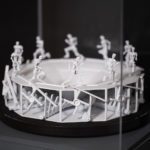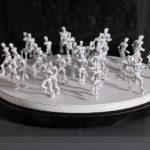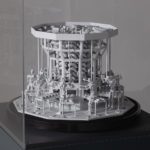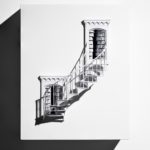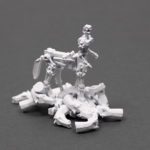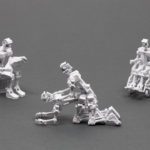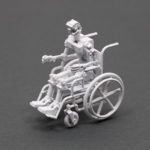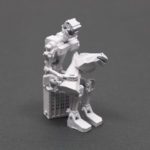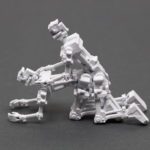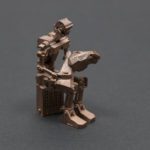Opening reception: Saturday, January 11, 2020 from 3 p.m. to 5 p.m.
Guillaume Lachapelle: Vitesse d’échappement
Art Mûr Montréal
Text by Andrea Valentine-Lewis
Much like a zoetrope – a pre-film animation device that creates the illusion of movement from the rapid succession of static pictures – Guillaume Lachapelle’s new work in Vitesse d’échappement produces this very illusion of movement but instead of using flat pictures, he uses 3-dimensional forms. These forms of 3D-printed artificial humans and inanimate mechanisms enable a uniform precision that affords this optical illusion. While everyday meanings of the term “mechanical” include: unemotional, impersonal, lifeless, and negligent, Lachappelle’s work defies these characteristics and generates a strong affective response. This response is not limited to the shock and awe we experience by the work’s illusion, but also, a deep and unsettling feeling at the not-so-distant future fusion of human and machine.
From the exterior of the vitrine, we are voyeurs to these miniature worlds of mechanical bodies who appear to be perpetuating tactless cycles; jolting forward in attempt to escape, thrashing arms in protest, and running from and over barriers, all to be sucked back into their inevitable fate. The figures are resilient as they continue to perform the same exact task in hopes that one final attempt will grant them the freedom they seek; however, they cannot and will not escape the gravitational pull or velocity in which they are stuck. These endless cycles are simultaneously admirable and terrifying as they connote a sort of dystopian reality where the function of repetition, at the very least, equates to a propelling motion forward. In other words, these cycles may appear unproductive and ineffective, and yet, the bodies continue moving ahead unscathed – a “flawless” system, much like the contemporary society in which we live.
Vitesse d’échappement includes a video component which breaks down these complex worlds into barebone drawings. Here, we begin to remind ourselves that machines are an extension of the organic human body and further, that we ourselves are also machines.
Lachapelle’s work interrogates notions around tangible surroundings and our conception and experience of them. While he is inspired by urban architecture and the patterns it assumes, his work continually alters these realities by integrating strategies of illusion. By including mirrors, alternative lighting schemes, and by playing with scale and dimension, Lachapelle’s works often ignite a dizzying feeling of vertigo. In Vitesse d’échappement, this feeling is amplified with the addition of rapid motion and mechanical human bodies. Although we may fear for the bodies who cannot escape the rigid cycles that keep them fastened immobile, we are paralyzed and cannot look away.


